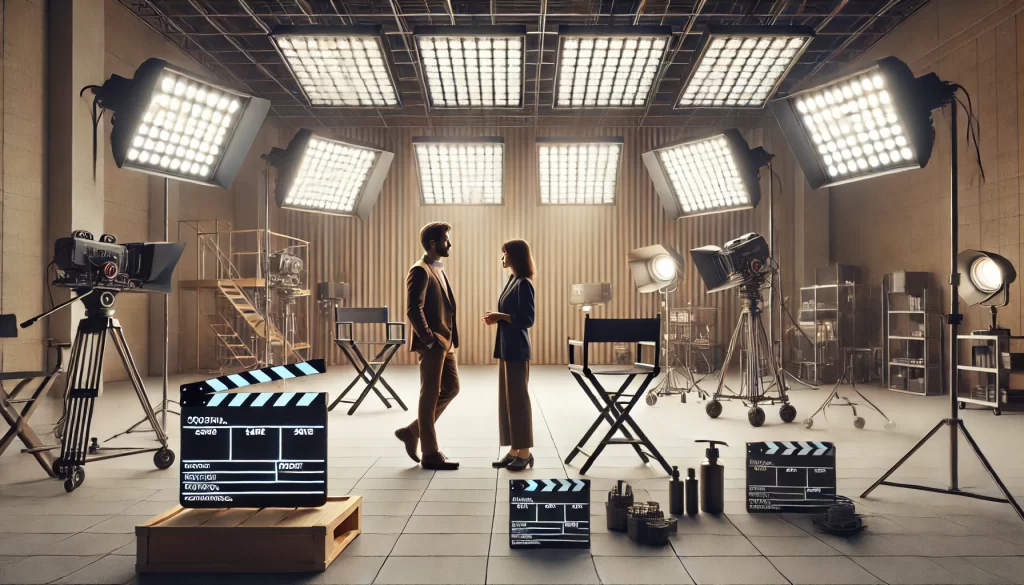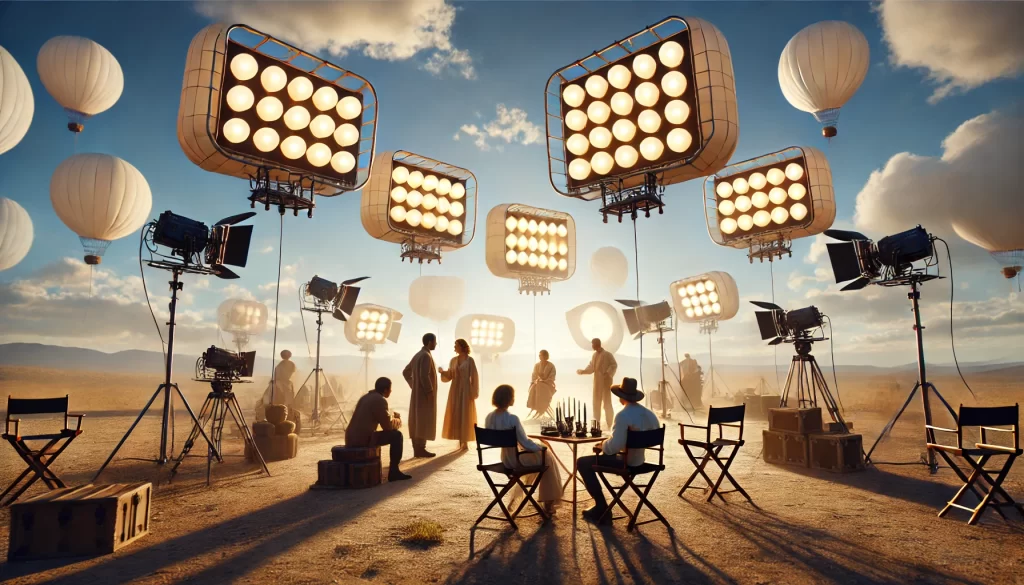Modern RGB flat sky-panel LED lights are often DMX-compatible, allowing them to integrate seamlessly into a larger lighting system.
The ability to use DMX for precise control of color temperature, brightness, and RGB hues offers unmatched flexibility, especially when multiple lights need to be adjusted simultaneously.
| Feature | App Control | DMX Control |
| Ease of Use | Very user-friendly with intuitive touch interfaces | Requires technical knowledge of DMX protocols |
| Flexibility | Ideal for small to medium-sized setups and remote adjustments | Excellent for large, complex setups with multiple lights |
| Control Type | Control from smartphones or tablets, wireless connection | Physical DMX controller or software, wired connections |
| Multi-Panel Control | Yes, can control multiple panels simultaneously | Yes, can control entire lighting rigs or multiple lights via channels |
| Distance | Limited to Bluetooth or Wi-Fi range | Can control over long distances with daisy-chaining cables |
| Integration | Best for basic setups or single units | Best for large-scale productions and complex setups |
On a film set, app control allows the director, DP, or gaffer to adjust lighting without needing to manually move or touch the panels. This is especially useful when adjusting light for different camera angles or for last-minute adjustments during a scene.
Example: In a fast-paced shoot, the ability to change the color temperature or intensity of a light via an app without interrupting the action ensures the scene maintains continuity and the crew can work efficiently.
For larger productions, such as theater performances, concerts, or live events, DMX control allows for the synchronization of multiple lights with other stage effects (e.g., sound, fog machines). A DMX-controlled system can ensure that each light is in the correct position and has the desired effect at precisely the right moment.
Example: In a concert performance, DMX control allows the lighting team to create dynamic light sequences that are synchronized with the music, enhancing the live experience.
For productions that span multiple locations or large sets, app-based control systems like LumenRadio or Artnet enable remote control of lighting from anywhere in the world. This is useful in virtual sets or location-based shoots where crew members may need to adjust lighting from different points across a large area.
Example: In a remote outdoor shoot, an app could allow the gaffer to adjust lighting setups on different panels across the location without having to run back and forth.
Both app-based and DMX control methods offer unique advantages in the realm of remote lighting control. For smaller setups and on-the-go flexibility, apps provide an easy, intuitive interface for controlling individual flat sky-panel LED lights. For large-scale productions with complex lighting rigs, DMX control is the gold standard, offering precise, synchronized control over multiple lighting units and enabling sophisticated effects. By using either or both control methods, filmmakers can greatly enhance their ability to manage lighting efficiently, with creative precision and ease.

In modern filmmaking and photography, complex lighting setups often require multiple light sources working in harmony to achieve the desired aesthetic. Whether you’re lighting a large set, a dynamic scene, or an entire stage, synchronized lighting can create visually cohesive effects, enhance mood, and ensure continuity. In these scenarios, synchronization ensures that the lights interact with each other consistently, allowing for smooth transitions, dramatic effects, and precise control over every aspect of the lighting.
For flat sky-panel LED lights, which often feature advanced capabilities like RGB control, dimming, and adjustable color temperature, effective synchronization becomes even more crucial. Here’s how you can synchronize lights for complex setups and take full advantage of their features.
Methods for Synchronizing Lights
DMX control is one of the most powerful methods for synchronizing lighting in large or complex setups. With DMX, you can connect multiple LED panels and control them from a single console, allowing you to adjust each panel’s brightness, color, and effects simultaneously or in a coordinated sequence.
Key Features of DMX Synchronization:
Multiple Channels: Each light can be assigned a DMX address to control specific parameters (e.g., brightness, RGB, color temperature) on separate channels. You can synchronize all the lights or control them individually for precise control over a scene.
Lighting Scenes and Cues: DMX enables you to program lighting scenes (predefined settings) and cues (specific actions) that can be triggered at specific points during the production. This is ideal for theatrical performances, concerts, or music videos where the lights need to change in sync with music or action.
Real-time Synchronization: DMX controllers like GrandMA or ETC consoles allow you to adjust the settings of multiple lights in real-time, either manually or through automated sequences, ensuring that the lighting effects remain consistent throughout the shoot.
Example: In a cinematic action scene, you may want to synchronize the lighting across several panels to create an explosive flash effect, where all lights fire simultaneously in a specific color (e.g., red or white), giving the effect of a gunshot or explosion. DMX lets you trigger this effect across all the lights at once, ensuring uniformity.
Many modern LED lighting systems, including RGB flat sky-panel LEDs, come with built-in wireless connectivity via Wi-Fi or Bluetooth, which allows you to control and synchronize multiple lights via apps or wireless DMX systems.
Key Benefits of Wireless Synchronization:
Ease of Setup: Wireless systems simplify the process of connecting lights without needing long cables, which can be cumbersome and limit mobility on set.
App Control: Many lighting brands offer dedicated apps that allow you to control lights remotely from smartphones or tablets. These apps often allow for group control, where you can adjust the settings of multiple lights at once and synchronize them.
Long-Range Synchronization: Some systems, like LumenRadio or Art-Net, allow you to control lighting setups over a large area without needing physical cables, making them ideal for large outdoor productions or multi-location shoots.
DMX Over Wi-Fi: In combination with Wi-Fi, wireless DMX systems enable remote DMX control over long distances, allowing for seamless lighting integration in large-scale setups.
Example: On a music video set, wireless synchronization enables the director or gaffer to quickly adjust the lights remotely without the need to manually adjust each light. This is especially useful when creating synchronized lighting effects with music or movement, such as flashing lights timed to the beat or changing color patterns in sync with the song.
Timecode synchronization is an advanced method for ensuring that lighting effects stay in sync with video, audio, or motion sequences during production. A timecode signal sends precise timing information to all connected devices, so they know exactly when to change or activate based on the recorded time.
How Timecode Synchronization Works:
Timecode signals (usually SMPTE timecode) are sent to each light and can trigger pre-programmed lighting effects that match specific frames in a film or video production.
This allows for seamless integration of lighting with video, ensuring that every lighting change happens at the right moment within a scene.
Example: In a chase scene for a film, lighting may need to sync with specific events, such as a flashing red light as a car speeds by or the color change in the lighting when a certain character enters the scene. With timecode synchronization, the lights will switch in perfect harmony with the action, maintaining continuity and immersion.
Some modern LED lights, including flat sky-panel LEDs, allow you to group multiple lights into zones or groups and synchronize them with a master controller. This is a useful method for lighting setups where you want to control groups of lights at once but still maintain the ability to tweak individual settings.
How Grouping Works:
Master-Slave Configuration: You designate one light as the master and others as slaves. The master light controls the settings of the slave lights, ensuring they all behave identically.
Zone Control: Multiple groups or zones of lights can be created, and each zone can be adjusted together or independently, depending on the lighting requirements of the scene.
Example: On a stage set, you could group several lights focused on the main character into one zone and others lighting the background into another zone. Adjustments made to the master light will synchronize with the slave lights, ensuring that the background and foreground remain consistent in lighting, whether for color shifts or brightness adjustments.
Practical Applications of Synchronizing Lights
For live shows, the lighting needs to change in sync with the music, audience movement, and special effects. DMX control can synchronize the entire rig to respond to cues in the audio or timecode, ensuring that lighting transitions smoothly and dynamically.
Example: As the music builds, lights can gradually change color from blue to red, synchronized with the music’s tempo, creating an immersive visual experience for the audience.
In fast-paced or action sequences, lighting can be used to simulate explosions, flashes, or light changes. By synchronizing the lighting with the camera movements or scene transitions, you can ensure that the lighting changes happen at the right time without distracting from the action.
Example: A flash of white light could occur just before a car explodes, synchronized with the camera cut to enhance the impact of the explosion.
In theater, live lighting cues are triggered by the actor’s movements, dialogue, or music cues. DMX controllers allow for precise timing of lighting changes, ensuring that the lights are synchronized with the stage action.
Example: In a dramatic stage scene, the lighting might shift from soft warm tones to cool blues as the mood changes, all in perfect sync with the actor’s lines or music cues.
In product photography, precise control of lighting angles and color can enhance textures and details. Synchronized lighting can ensure that multiple light sources illuminate the product evenly, adjusting in sync as the camera angle changes or different effects are applied.
Example: For a 360-degree product shot, synchronized lights can rotate or change intensity to illuminate the product evenly from every angle.
Synchronizing lights for complex setups involves careful planning and the right tools. DMX, timecode synchronization, wireless control, and grouping lights all offer powerful methods for achieving precise, coordinated lighting effects. Whether you’re working on a film set, live event, music video, or theatrical performance, synchronized lighting ensures that the visual experience remains consistent, dynamic, and impactful, elevating the overall production value and storytelling potential.
LED lights have become an essential tool in modern filmmaking, particularly for budget-conscious filmmakers. Offering a wide range of affordable, efficient, and versatile options, LED lights allow filmmakers to achieve high-quality lighting without the steep costs typically associated with traditional lighting setups. Here’s how filmmakers can benefit from LED technology when working within a budget:
LED lights have come down significantly in price over the years, making them more accessible to independent filmmakers, small studios, and anyone looking to keep production costs low.
Affordable Entry Point: While high-end LED panels with advanced features may still come with a higher price tag, there are many budget-friendly options that provide excellent lighting quality for smaller productions.
Wide Range of Options: Budget-conscious filmmakers have a wide selection of LED lights to choose from, such as compact panels, portable on-camera lights, and budget-friendly studio kits.
One of the most significant financial advantages of using LEDs is their low power consumption compared to traditional lighting options like tungsten or HMI lights.
Energy Efficiency: LEDs consume far less power than traditional incandescent lights, which can significantly reduce electricity bills over the course of a shoot, especially during long filming days or in large setups.
Extended Use: LEDs’ lower power requirements also allow filmmakers to use more lights in a scene without worrying about excessive energy consumption. This means you can create complex lighting setups with multiple LED panels without driving up your utility costs.
(To Be Continued)
Get in touch for free lighting customization